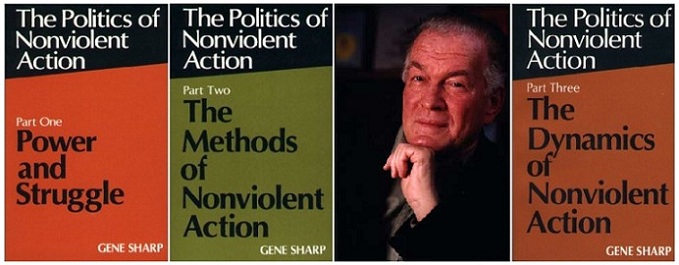[ cross-posted from Zenpundit, with thanks to Lex for the nudge ]
I was impressed by him in London in the early sixties.
Okay, I was young and impressionable. But others have noticed him more recently, too: Hugo Chavez accused him of being a conspirator with the CIA, and the Iranians thought he, George Soros and John McCain were in cahoots.
Gene Sharp has been in the news quite a bit recently [1, 2, 3, 4], because he pretty literally wrote the book on non-violent resistance.
The young leaders of the Egyptian revolt that toppled Mubarak studied tactics with members of the Serbian Otpor youth resistance who topped Milosevic, Otpor studied tactics in the writings of Gene Sharp, specifically his 90-page pamphlet From Dictatorship to Democracy [download as .pdf]. Sharp wrote that handbook for use in Burma, where it was apparently translated at the request of Aung San Suu Kyi — who once cautioned her readers that that phrase they kept hearing wasn’t “jeans shirt”, it was “Gene Sharp”.
And before that, he’d penned his masterful 900-page, three-volume work, The Politics of Nonviolent Action…
I told you he was impressive.
Recommended reading:
From Dictatorship to Democracy is now available in Amharic, Arabic, Azeri, Belarusian, Burmese, Chin (Burma), Jing-paw (Burma), Karen (Burma), Mon (Burma), Chinese (Simplified Mandarin), Chinese (Traditional Mandarin), English, Farsi, French, Indonesian, Khmer (Cambodia), Kyrgyz, Pashto, Russian, Serbian, Spanish, Ukrainian, Tibetan, Tigrigna, and Vietnamese.

I’m not familiar with Sharps work but I will say this: Non-violence only works to the degree that the guys with the most guns want it to.
I note that today is the anniversary of the execution of the members of the White Rose society in Munich in 1943. Passive resistance against the Nazi just meant less effort for Nazis. Passive resistance only works against people who are not utterly ruthless. It was useless against Hitler, Stalin, Mao etc.
When you look at the details of uprisings like those we are seeing now, the critical turning decision is always the one the military makes. If the military supports the uprising, the regime falls. If the military supports the regime, they massacre the protestors and the regime survives. If the military is divided, a shooting civil war erupts.
People protesting in the streets are really talking to the military. They really have to convince the people with guns and organization to join them or at least not shoot the protestors. Only when the military at least stands aside does non-violent methods have a chance to even begin working.
Hi Shannon:
I haven’t read it myself, but Peter Ackerman and Christopher Kruegl tackle that issue in their book, Strategic Nonviolent Conflict: The Dynamics of People Power in the Twentieth Century (Praeger, 1993) according to this review in Reason magazine:
I’m no historian, and don’t want to argue the finer points of that analysis -– but the interest of the nonviolent techniques Gene Sharp has cataloged is not that they will always triumph against any adversary. It is that they are powerful means by which a large and oppressive force can be at times impeded, at times contained, and at times even defeated – and that their power to do so is often overlooked by those who, without first becoming acquainted with them, assume them to be “pacifistic” – they are anything but passive – and hence, “weak”.
Here are some excerpts from Fr. Thomas Merton’s writings on the Danish Resistance to Hitler, from his book, The Nonviolent Alternative (1980), pp 165 ff:
Finally, here’s a quick quote from an article I ran across just now, describing another instance of nonviolent resistance to the Nazis, this one in Germany:
It seems to me that what we have in the work of Sharp and those who have followed him is an under-studied body of knowledge — not a panacea, perhaps, but a significant addition to our armamentarium.
*
I’m going on at such length about this because I haven’t studied Sharp’s work any time recently, and feel the need to catch up, and because I welcome exposure to the views and arguments of Shannon and others here on CBz.
I’m here to learn.
There is no hard and fast rule here. The use of a strategy nonviolence, like the use of a strategy of violence, is a continuation of political intercourse. Successful government turnovers generally follow a fatal split in a governing elite. If nonviolence brings about such a political effect, even under the most repressive regime, it is a useful tactic. If not, the streets will run with blood.
The outcome of any political maneuvering is ultimately determined by control of the means of violence. If the Danes had been Slavic or Jewish the result of their effective nonviolence may have been Lidice on a larger scale.